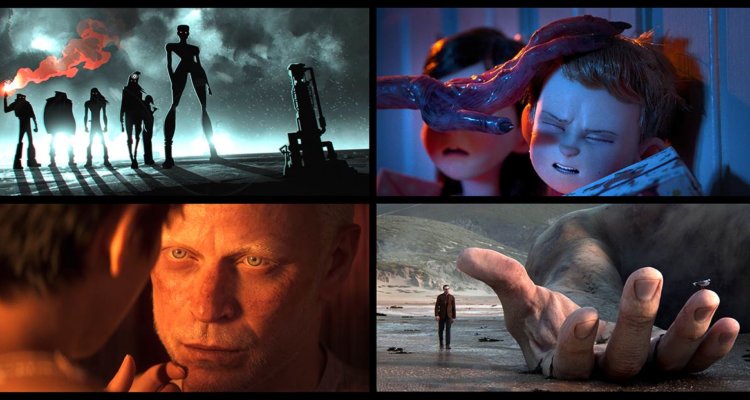When the first volume of Netflix’s “Love, Death + Robots” dropped, different accounts were reportedly treated to divergent episode orders, possibly identifying any specific short(s) affecting the audiences’ intake – allowing Netflix to gauge the uniquely curated program’s bingeability model. Also, likely, gathering data on whether 18 shorts for a single season would be seen as an excessive/necessary endeavor (based on who watched how many vs. who dropped off after only viewing a handful). The second season of the streaming platform’s “Heavy Metal” magazine-inspired, sci-fi anthology (exec-produced by Tim Miller and David Fincher) reduces the episode count to only eight shorts this time around (with eight more slated for the show’s already green-lit third volume). This allows for more fully formed, imaginatively rendered visions, highlighting modern-day animation’s latest aesthetic innovations. Still, it sadly also means fewer animation styles and a whole lot less to chew on narratively (less naked ladies too, which will be a major plus or minus, depending on who you ask).
The first volume of the series was far from perfect, but it unapologetically committed to what it was; dripping and oozing with a wide range of purposefully graphic visuals and transportive genre ideas – some so stupid they’d make your head spin, which was entirely the point. Not to say that Volume 2 is not an overall worthy successor to the first 18 shorts, but rather a creative letdown, overall, given the amount of time between seasons and the series’ off-center sandbox potential. The eight new stories amount to less than two hours runtime total, which ends up making it feel not unlike an extremely watchable, throwaway genre exercise/random movie you press play on to fall asleep to, such as the recently released “Stowaway.”
READ MORE: Summer TV Preview: Over 40 Series To Watch
Eschewing a larger assortment of expressive experimentation in favor of tighter and often safer narrative frameworks – most directly based on SF short stories ranging from classic authors like Harlan Ellison to contemporaries such as Paolo Bacigalupi – every episode is remarkably pristine and polished. Still, three of the stories come from the same animation studio (Blur Studios). While the sums of their parts amount to far more than the world’s best looking “Gears of War” cutscenes, they have started to fall into the category of “same-y feeling steaming content,” which goes against the grain of the show’s conceptual appeal. The best-looking episode “Pop Squad” (helmed by Jennifer Yuh Nelson) looks like an uncanny cross between “Seven” and “Blade Runner: 2049,” yet compositionally combining two visual masters like Roger Deakins and Darius Khondji results in a standard, by the numbers, rotting moral compass detective story.
READ MORE: The 65 Most Anticipated TV Shows & Mini-Series Of 2021
At times (such as in the short “Life Hutch”), you might find yourself blinking profusely to be sure Michael B. Jordan isn’t actually on your television, but it seems animation still has some hurdles to jump when it comes to voice-over work. There is often a significant disparity between the artistic rendition and the lip-syncing, which can be a significant distraction after watching a fairly dialog-less narrative stretch. Miraculously juxtaposing scale and perspective, the second short, “Ice,” is the standout from an animation standpoint, starting like an Arctic-set, Phil Hester horror comic, and morphing into a “Tron Legacy” -lite chase across a frozen body of water; it’s the closest the season comes to crafting an equivalent to Volume 1’s gorgeous “Zima Blue” (both shorts being directed by Robert Valley).
READ MORE: The 25 Best TV Shows & Mini-Series Of 2020
Similarly, one of Volume 2’s strongest outings is its opener, “Automated Customer Service,” which comes courtesy of the mind of brilliant satirist John Scalzi (if you’re a ‘Trek’ fan and haven’t read his award-winning novel “Redshirts,” stop what you are doing and grab a copy). Much like last season’s “When the Yogurt Took Over,” it’s deceptively juvenile in its crackpot jubilant approach and makes for a wonderfully asinine exercise in comedic escalation. By contrast, by bookending the new batch of shorts with its most melancholic episode, “The Drowned Giant” (helmed by Miller), Volume 2 plays more like a curated story collection rather than a strange comic book anthology (not necessarily a bad thing, just operating on a simpler wavelength than what some may expect).
Summer TV Preview: Over 40 Series To Watch
Most of the tales deal with mortality, technological malfunctioning, or some combination of the two. The atmosphere of most has more of a Shyamalan/Spielberg flavor this time around (particularly the episode “Tall Grass”). Luckily, only one is a real stinker (and mercifully the shortest of them all), but a couple comes off as recycled versions of tried and tested tropes. It’s hard to make your short not feel indebted to “Alien” or “Jurassic Park” at you’re aiming for that influence box, but at what point does aesthetic tribute turn completely meaningless? In today’s landscape of never-ending content production, that question is turning more and more prevalent.
Though its narrative reach and explorative curiosity have been lessened, “Love, Death + Robots” still makes for a tremendously entertaining watch, albeit a very, very short one. Ideally, the third volume can find a meeting ground somewhere between the two disparate batches of stories; the short story adaptation approach can certainly work, but, given the medium Miller and Co. are playing in, a tad more sensory-driven animated eye-candy would better allow the series stand out to its audience. [B/B-]

